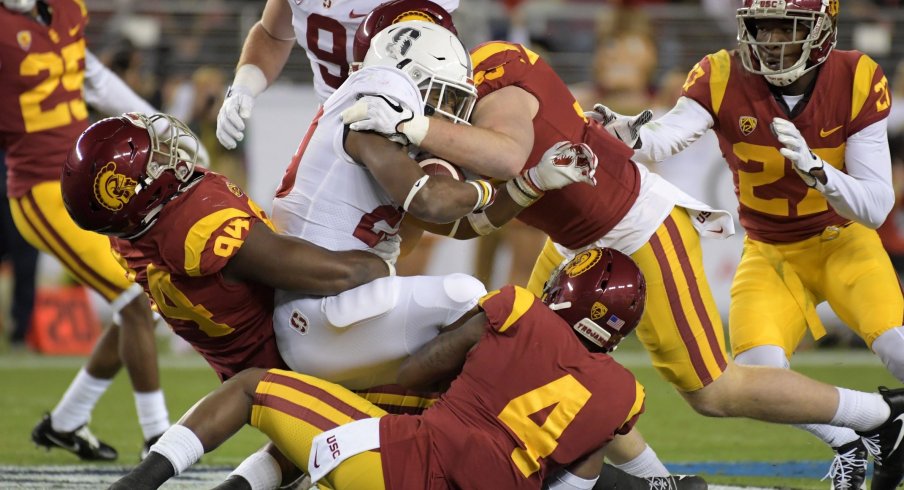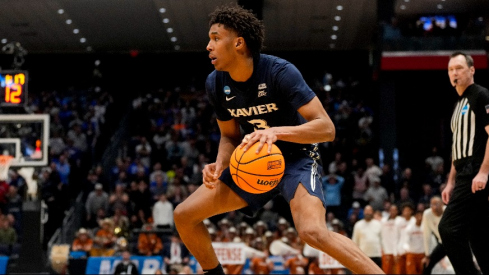This was supposed to be an offseason project.
Instead of spending months mastering the fine intricacies of a lesser-known, yet extremely successful, system in advance of a trip to AT&T Stadium, the plans have changed. Ohio State is scheduled to take on TCU and Gary Patterson's vaunted 4-2-5 defense back in Arlington in just over nine months' time, but with a Cotton Bowl matchup against USC looming, the Buckeyes have had to begin prep work for this unique look earlier than expected.
Under the watch of coordinator Clancy Pendergast, the Trojans operate a 4-2-5 system similar to the one made famous in Ft. Worth, as his old school, 5-2 defense has evolved to meet the challenges posed by modern spread offenses. Long focused on stopping the run first, Pendergast's defense removed a stand-up end/outside linebacker in favor of a third safety to match the speed presented by three and four-receiver sets on the opposite side.
But unlike 4-3 defenses like Ohio State's that break their personnel into three distinct units (line, linebackers, and secondary), 4-2-5 systems break the defense in half, divorcing the front six from the back five. Once separated, the secondary splits yet again, with different responsibilities to each half of the field similar to the way Quarter-Quarter-Half coverage asks defenders on one side of the field to play Quarters while the other half play Cover-2.
The strong side in this setup is often referred to as the Read side with the weak known as Away. How the strength is determined can change from team to team, but the Trojans tend to call the Read side to the field (wide side), which is how many high school coaches that implement the system operate for the sake of simplicity.
Once the strength is set, the Trojans will call any number of coverages, including basic man-coverage (a.k.a. Cover-0), Cover-2, and the various two-man, pattern-matching adjustments that can be run from Quarters coverage, known as Blue in 4-2-5 nomenclature. But USC's favorite scheme is a form of Robber coverage in which the free safety can read the quarterback's eyes and "rob" the middle of the field as long as the #2 (slot) receiver runs an underneath route.
In that coverage, which we'll call 2-Robber, if all four receivers run vertical routes, the defense looks like basic Quarters, as both corners and the two deep safeties essentially man-up with each target downfield. The third, underneath safety, drops to a zone in front of the #1 receiver looking for backs to release his way on a pass pattern.
But the coverage responsibilities to the Robber side change depending on the routes run by the offense, which can cause major confusion for a quarterback trying to read the defense on the fly. That uncertainty allowed the Trojans to rack up 16 interceptions this season, the 14th-best total in all of FBS.
When facing three receivers to one side, the 2-Robber coverage simply asks the cornerback outside to run a Special check, meaning he effectively takes the #1 receiver in man-coverage while the three safeties employ their 3-over-2 rules against the inside receivers as if the outside man isn't there. On the Away side, the corner also mans up against the lone receiver, usually dropping quickly and playing soft coverage given that he has no help over the top from a safety.
As you can probably guess, this coverage places a great deal of trust in the Trojan cornerbacks and leaves them exposed to quick, three-step routes like outs, slants, and hitches.
But the reason Pendergast calls for 2-Robber so often is the way it inserts the free safety as an extra hitter against the run. Much like Bud Foster's Virginia Tech 4-2-5 or the Michigan State 4-3 Quarters systems, which stymied the Buckeye running game by adding a safety back into the box and gaining the numerical advantage back in their favor, the Trojans look to do the same from an extra defender in the middle of the field.
Marvell Tell (#7) mans this critical position for the Trojans, reading the actions of the offensive tackle to determine a run or pass read. If he sees the tackle step forward, signaling a run, the safety comes downhill working inside-out and filling the hole a quarterback looking to run expects to be open.
This technique is known as a Scrape-Exchange, and is a common defense for shotgun option plays in which a player on the line is left unblocked to be read by the quarterback. Normally, that line player (often an end) simply steps inside to take away the run and gives the quarterback the signal to keep for himself while an inside linebacker fills that outside gap, exchanging responsibilities with the end.
But in the 4-2-5, the inside linebackers are just that, ensuring all run gaps between the tackles are properly filled. This leaves the free safety playing a Robber role to read the tackle and act as the exchange player with the end to shut down quarterback runs.
But just as the secondary's soft coverage off the line allows for quick, three-step routes in the passing game, the Trojans' deep alignment is weak against gap running schemes to the outside that pull a lineman as a lead blocker.
Notre Dame exploited this weakness all night long in their dominant 49-14 victory over USC back in October, adding compressed formations that allowed cracking wide receivers to seal the edges and get blockers out in front of the runner. The Irish tallied 377 rushing yards that night against Pendergast's defense, with a staggering 8.02 yards-per-carry thanks to schemes like the G-Sweep that pulled both guards around the edge.
While Notre Dame's front five was recently named the best offensive line unit in the nation, thanks in part to their performance against USC, the Buckeyes should feel confident about their ability to move the ball on the ground against this unique defensive setup. Billy Price has proven to be an adept puller from his center position, and the commitment to running the ball outside in the victories over Michigan and Wisconsin showed Kevin Wilson and Ryan Day aren't afraid to call for such schemes.
Of course, Ohio State will have to execute in the passing game to keep Tell and Chris Hawkins (#4) from cheating into the box from their safety spots. When those two creep up to the line, the Buckeyes will have chances in the deep passing game as the Trojan defensive backs are effectively left on islands with no help from a deep safety, meaning J.T. Barrett shouldn't shy away from looking downfield despite the team's struggles to connect on such throws recently.
But overall, Barrett, Price, and the rest of the Big Ten champions should look to impose their will on their opponents from the west coast, as despite their complex system, the Trojans have regularly failed to produce on the defensive side of the ball. Pendergast's unit ranks 69th nationally in yards-per-play this season, which is not respective of the Pac-12's explosive offensive slant as they rank 5th in the conference.
More importantly, the unit struggled to match the physicality presented by the spread-to-run offenses of the Irish or Rich Rodriguez's Arizona Wildcats, both of whom closely resemble the Urban Meyer's philosophy for running the football, but not just because they also feature shotgun, option runs. Like Ohio State, those two programs instill sound fundamentals in their offensive linemen, which allowed them to control the line of scrimmage and get blockers to the second level against the Trojan linebackers and safeties.
Essentially, the challenge for Wilson, Day, and the Buckeyes will be to simply decipher and recognize how this system is different from what they've seen for much of this season, knowing that it's not executed with the same precision as what they'll see from TCU in September. It certainly won't hurt to get the extra practice in advance of Ohio State's next trip to Texas, though.



